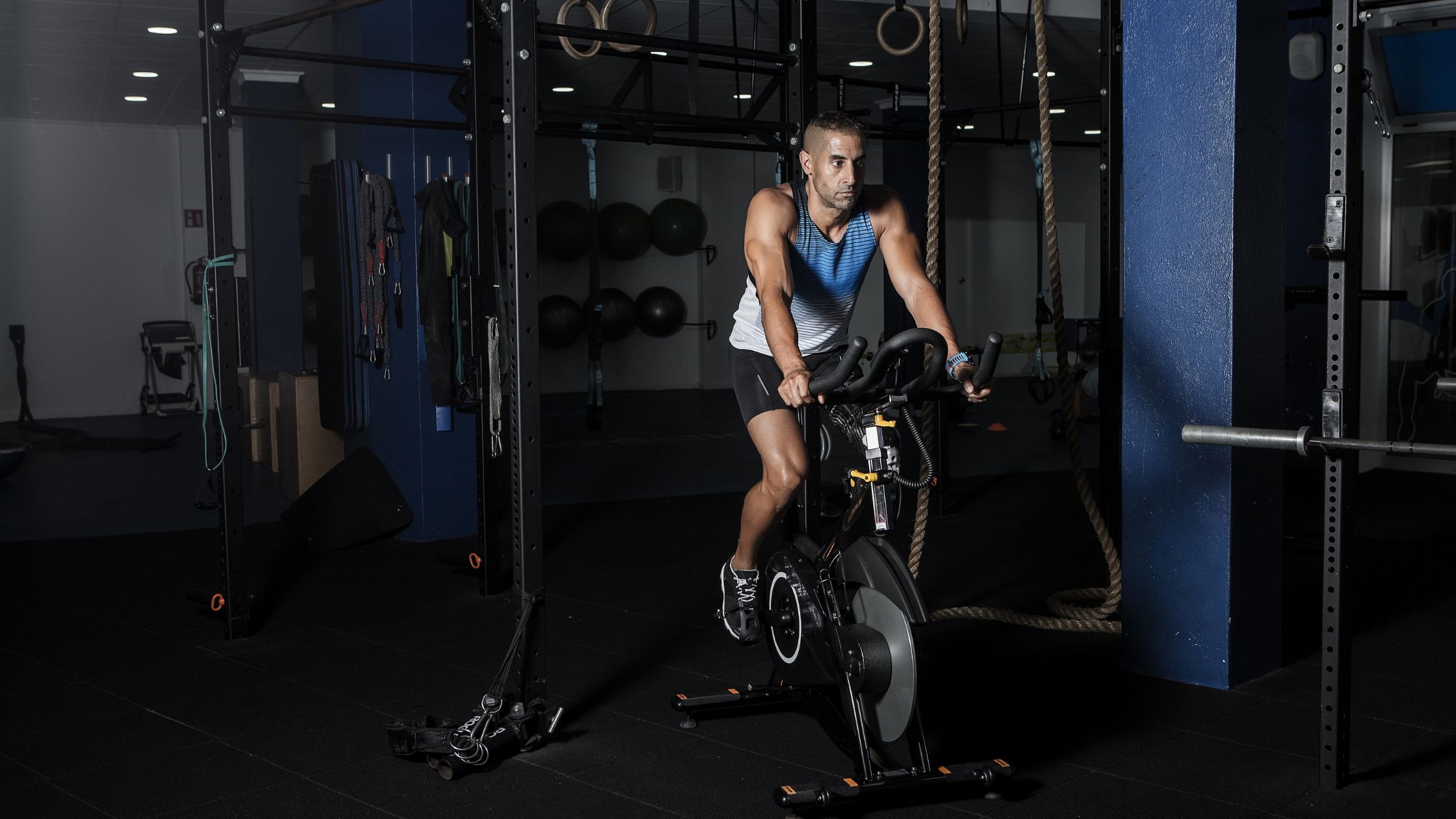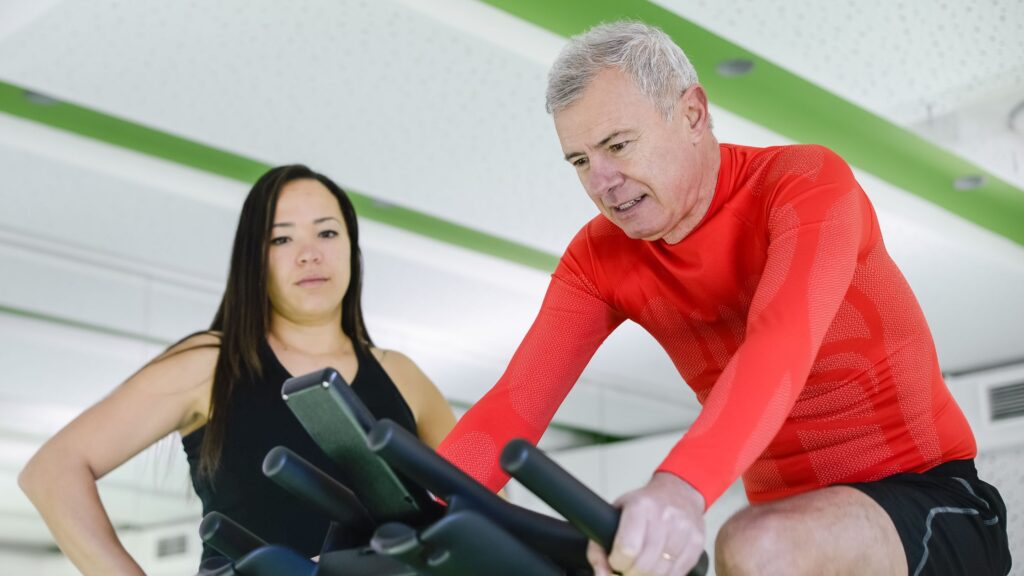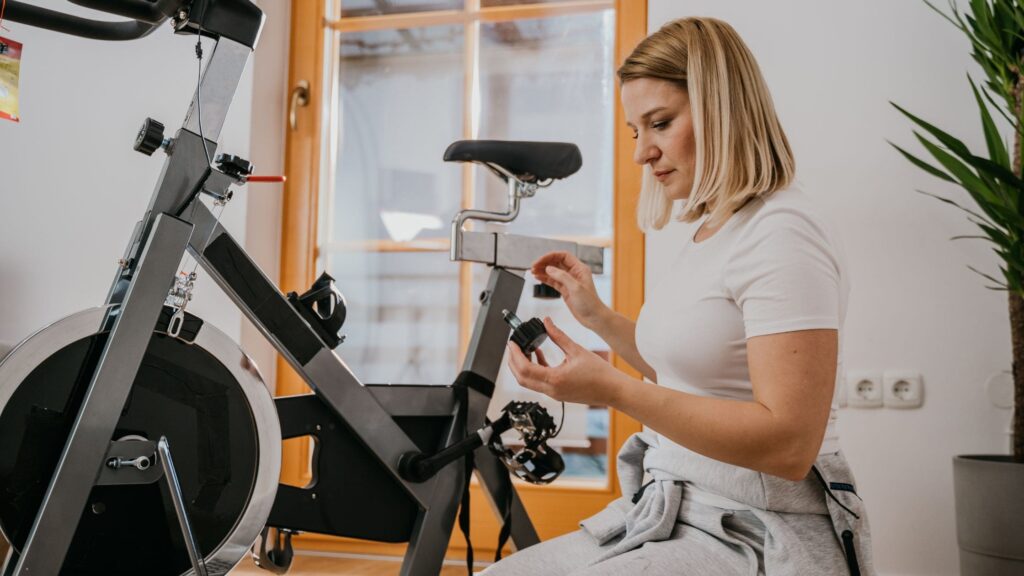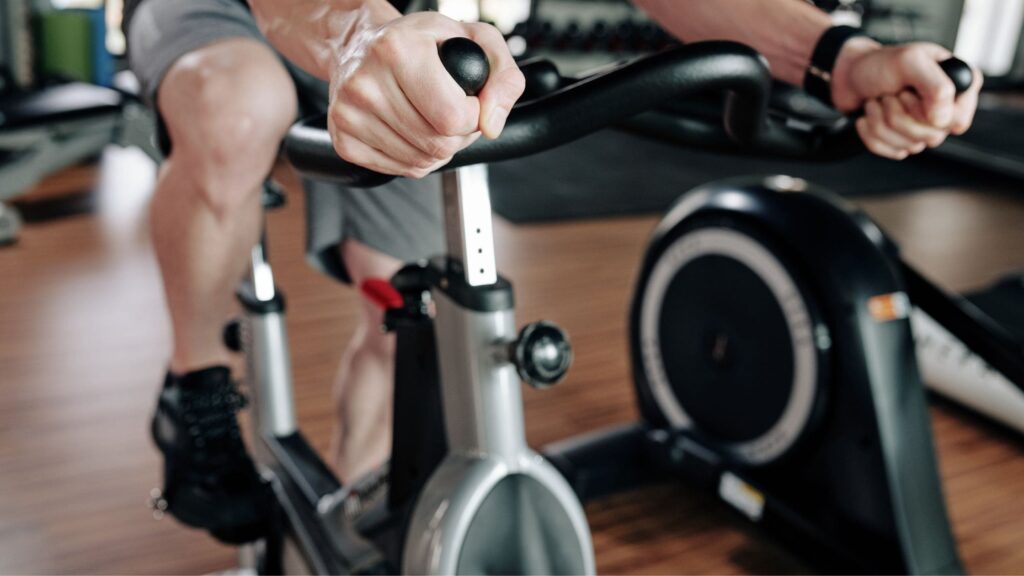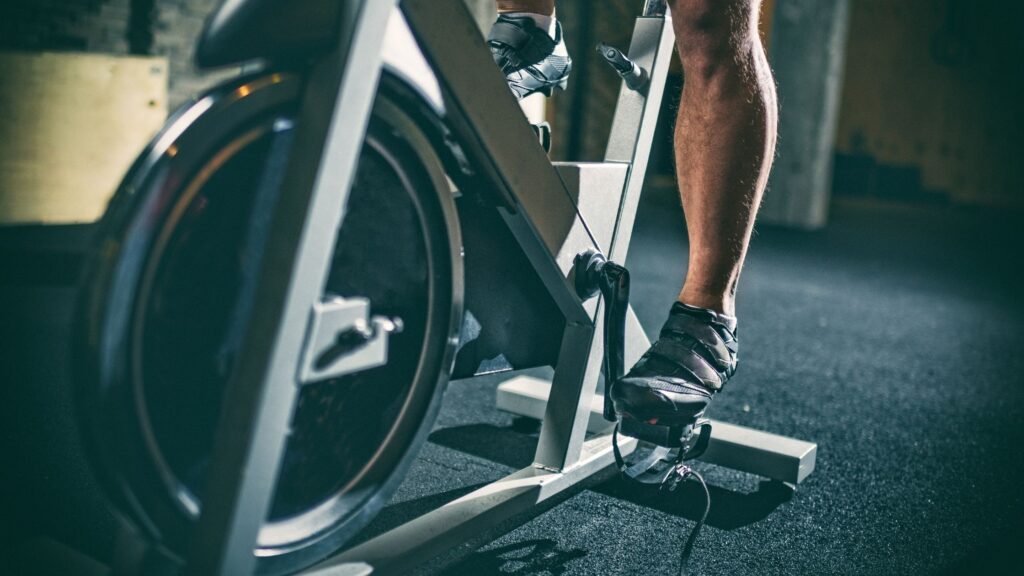Stationary bicycles stand out as a versatile choice, offering low-impact cardiovascular workouts that cater to various fitness levels.
It doesn’t matter if you’re aiming to shed pounds, boost endurance, or simply stay active, choosing the right stationary exercise bicycle provides a joint-friendly alternative to high-impact exercises.
Their compact design makes them suitable for home gyms, fitting seamlessly into spaces like your living room or dedicated workout area. By adjusting resistance levels, you can tailor your workouts to match your goals, ensuring both safety and effectiveness.
In this article, we’ll discuss how to choose a stationary bicycle, so you can buy the best exercise bike that aligns with your fitness aspirations.
What Is a Stationary Bicycle?
A stationary bicycle, also known as exercise bike, is an indoor fitness machine designed to mimic outdoor cycling while allowing users to control resistance, intensity, and workout duration. It typically includes adjustable seating, a resistance system, and a console to track workout data.
Unlike traditional bicycles, stationary models remain fixed in place, making them ideal for consistent training regardless of weather conditions. They are widely used for endurance workouts, interval training, and rehabilitation exercises. Many models offer adjustable resistance levels, enabling users to increase or decrease intensity based on their fitness needs.
Advanced bikes feature digital displays, smart tracking, and even app connectivity for guided training sessions. Some include ergonomic designs such as recumbent frames for added comfort, especially for users with lower back or joint concerns. High-end models may also incorporate automated resistance adjustments similar to weight machines, allowing seamless intensity transitions.
How to Choose the Right Stationary Bicycle for You?
Selecting the right stationary bike depends on your fitness objectives, space availability, budget, and comfort preferences. Whether you’re looking for a low-impact option for rehabilitation, an intense cardio machine for interval training, or a compact model for a small apartment, each type exercise bike has specific advantages.
Space constraints are an important consideration—upright and folding models are ideal for smaller homes, while recumbent bikes require more room. Budget also plays a role, as feature-rich models with app connectivity and performance tracking tend to cost more.
Comfort should not be overlooked. Adjustable seats, ergonomic grips, and a smooth resistance system contribute to an enjoyable workout experience. Maintenance requirements vary as well; air bikes and friction-based models may need more upkeep than magnetic resistance bikes.
What are the Different Types of Stationary Bicycles?
Different models cater to various needs, from rehabilitation and low-impact exercise to high-intensity interval training. Some bikes prioritize comfort and accessibility, while others replicate outdoor cycling with heavier flywheels and performance-driven features.
The most common types include upright, recumbent, indoor cycling, air, folding, dual-action, mini, desk, and commercial bikes. Some models incorporate advanced features like interactive displays, app connectivity, and real-time resistance adjustments, while others focus on simplicity with manual controls.
Space is also a key factor. Some bikes require dedicated workout areas, while compact models like folding or mini bikes are designed for small living spaces. For advanced training, indoor cycling and air bikes are popular choices, often seen in group fitness classes.
Certain high-end bikes use features similar to specialized gym equipment, such as pneumatic resistance for precise tension control. However, most stationary bikes do not utilize plate-loaded mechanisms or selectorized weight adjustments, focusing instead on resistance-based progression.
Below are the ten main types of exercise bikes.
Upright Bikes
Upright bikes closely resemble traditional outdoor bicycles, featuring a compact frame, raised seat, and forward-leaning handlebars. They are designed for moderate to high-intensity cardio workouts while maintaining a relatively low impact on joints.
These bikes are ideal for home use due to their smaller footprint. They typically include adjustable seats and handlebars, allowing for personalized positioning. Some models offer preset workout programs and resistance controls to adjust intensity levels.
Pros
- Space-efficient and suitable for smaller home gyms.
- Generally more affordable compared to advanced indoor cycling models.
- Provides an effective cardiovascular workout without requiring extensive setup.
Cons
- The smaller seat may be uncomfortable for prolonged use.
- Lacks the back support of a recumbent bike, which can be an issue for users with lower back concerns.
Recumbent Bikes
Recumbent bikes are designed with a reclined seat, offering enhanced comfort and support for the lower back. This design reduces stress on joints, making it a great option for seniors, individuals recovering from injuries, or those seeking a more relaxed cycling experience.
These bikes provide stable pedaling, distributing weight more evenly across the seat. Many models come with ergonomic adjustments to accommodate different body types, with some supporting user weights up to 400 pounds.
Pros
- Comfortable seat with back support, ideal for long sessions.
- Minimizes joint stress, making it suitable for rehabilitation and low-impact cardio.
- Allows for hands-free operation, which can be beneficial for multitasking.
Cons
- Larger footprint requires more space than upright or folding bikes.
- Not ideal for high-intensity workouts or cycling that involves standing.
Indoor Cycling Bikes
Indoor cycling bikes, often referred to as spin bikes, are designed to replicate the experience of road cycling. They are commonly used in high-intensity workout routines, including structured cycling classes. Many models feature a heavier flywheel, typically around 30 pounds or more, to ensure a smoother ride and greater momentum. Resistance is usually controlled through a knob, with friction or magnetic systems allowing users to adjust intensity levels quickly.
Some advanced models integrate technology similar to plate-loaded gym machines, allowing fast and precise adjustments to resistance levels. Because of their free-moving design, indoor cycling bikes are favored by those who prefer a more dynamic and unrestricted workout.
These bikes support an aggressive forward-leaning posture, similar to outdoor racing bikes, and some include clip-in pedals for a more secure foot connection. They are particularly effective for endurance building, interval training, and fat-burning workouts.
Pros
- Ideal for high-intensity workouts and group training.
- Supports standing pedaling for added resistance and versatility.
- Encourages a more immersive riding experience similar to road cycling.
Cons
- Smaller saddles can be uncomfortable for beginners.
- Friction-based models require occasional maintenance due to pad wear.
Air Bikes
Air bikes use a fan-driven resistance system that scales with effort—the harder you pedal, the more resistance you generate. Unlike traditional stationary bikes, air bikes often include moving handlebars, engaging the upper body along with the legs for a full-body workout.
These bikes are particularly effective for short, intense bursts of exercise, making them a popular choice for HIIT and CrossFit-style workouts. Their ability to provide self-adjusting resistance means they can accommodate different fitness levels without manual adjustments.
Pros
- Provides a total-body workout by incorporating arm movement.
- Resistance automatically adjusts based on pedaling intensity.
- Well-suited for high-intensity cardio and calorie-burning sessions.
Cons
- The fan mechanism produces more noise than other stationary bike types.
- Lacks pre-programmed workout options found in digital models.
Folding Bikes
Folding bikes are compact, space-saving exercise machines designed for easy storage. They feature a collapsible frame, making them ideal for small apartments, offices, or temporary workout spaces. Most folding models include a lightweight flywheel, basic digital displays, and adjustable resistance.
These bikes cater to users who prioritize convenience over high-intensity training. While they are effective for light to moderate cardio workouts, they typically lack the durability and resistance range of larger stationary bikes.
Pros
- Ideal for users with limited space.
- Generally more affordable than full-sized stationary bikes.
- Lightweight and easy to move when not in use.
Cons
- Limited resistance levels, making them less suitable for intense workouts.
- Smaller frames may not be as stable for heavier users.
Dual-Action Bikes
Dual-action bikes are designed to provide a full-body workout by incorporating moving handlebars that engage the upper body while pedaling. This design allows for simultaneous arm and leg movement, increasing cardiovascular intensity and overall calorie burn. Unlike air bikes, which use a fan for resistance, dual-action models may have magnetic or friction-based systems.
These bikes are commonly used for cross-training because they activate multiple muscle groups at once. They can help improve endurance, strength, and coordination, making them a good option for users looking for a more dynamic workout.
Pros
- Engages both the upper and lower body, enhancing calorie burn.
- Can quickly raise heart rate, making it effective for cardio training.
- Suitable for users looking to incorporate resistance training into cycling workouts.
Cons
- Coordination may take time to develop, especially for beginners.
- Not ideal for those who prefer focusing solely on leg endurance.
Spin Bikes
Spin bikes are a popular choice for high-energy, studio-style cycling workouts. These bikes feature an exposed flywheel, which contributes to a smooth pedaling experience. Resistance is adjusted manually using a knob, allowing for quick transitions between light and heavy tension.
These bikes are built for riders who enjoy intense, structured workouts such as interval training, standing sprints, and simulated hill climbs. The forward-leaning posture mimics outdoor road cycling, and some models include clip-in pedals for a more secure ride.
Pros
- Excellent for calorie-burning, endurance building, and intense cardio sessions.
- Adjustable resistance allows for customized workout intensity.
- Used in group classes, offering a motivational atmosphere for riders.
Cons
- Narrow saddles can be uncomfortable for long rides.
- Friction-based models require occasional maintenance due to pad wear.
Mini Exercise Bikes
Mini exercise bikes are compact, pedal-only machines designed for convenience and light activity. They can be placed on the floor for lower-body workouts or positioned on a desk for arm cycling. While they do not provide the same resistance levels as full-sized stationary bikes, they are useful for improving circulation, engaging in light exercise, or maintaining movement throughout the day.
These bikes function similarly to hydraulic-based mini machines, offering low-resistance movement that is beneficial for rehabilitation and gentle exercise. Ensuring proper placement on a stable surface prevents slipping, much like maintaining correct form on larger gym machines.
They are often recommended for seniors, rehabilitation patients, or individuals with limited mobility. They offer a simple, portable solution for staying active, especially in small spaces.
Pros
- Extremely portable and easy to store.
- Allows for passive exercise while sitting at a desk or watching TV.
- Good for light cardio and rehabilitation purposes.
Cons
- Limited resistance options, making them less suitable for high-intensity workouts.
- Stability may be an issue if not placed on a non-slip surface.
Desk Bikes
Desk bikes combine functionality with movement, allowing you to stay active while working or studying. Unlike traditional stationary bikes, these models feature a built-in desk surface or are designed to fit under a workstation. They encourage consistent low-intensity pedaling, making them a great option for increasing daily activity without disrupting tasks.
These bikes are best suited for steady-state cardio and improving circulation. However, they are not ideal for intense workouts since their design prioritizes seated comfort over high resistance levels. Proper seat and desk height adjustments are crucial to prevent back and wrist strain during extended use.
Pros
- Allows for multitasking, keeping you active while working.
- Promotes calorie burn and circulation throughout the day.
- Space-efficient and designed for long-term seated use.
Cons
- Not intended for high-intensity cardio or strength training.
- Desk positioning may not be ideal for very tall or short users.
Commercial Stationary Bikes
Commercial stationary bikes are built for durability and high-performance use in gyms, rehabilitation centers, and professional training facilities. These bikes feature reinforced steel frames, extended warranties, and high user weight capacities, often supporting 350 pounds or more. They are designed for long-term reliability, with robust drive systems and advanced digital consoles offering multiple training programs.
Due to their high build quality, commercial bikes require more space and a higher budget. They are well-suited for users seeking consistent performance, advanced tracking features, and long-lasting equipment. Many include smart connectivity options, allowing access to virtual workouts and user performance tracking.
Pros
- Engineered for heavy daily use with top-tier stability.
- Highly adjustable to accommodate multiple users.
- Offers premium tracking features and workout customization.
Cons
- Higher cost, making them less practical for casual users.
- Larger footprint, requiring dedicated workout space.
Now, let’s go into other factors like goals, comfort and budget
Fitness Goals
Your workout objectives should guide your choice of exercise bike. If you need a low-impact option for rehabilitation or general fitness, a recumbent bike provides back support and stability. Those focused on endurance and steady-state cardio might prefer an upright or indoor cycling bike.
For individuals looking to incorporate high-intensity workouts, air bikes offer dynamic resistance that increases with effort. If full-body engagement is important, dual-action models allow simultaneous arm and leg movement, enhancing overall conditioning.
Available Space
Before purchasing a stationary bike, evaluate your workout area to ensure it accommodates your chosen model. Most bikes require at least 10 square feet of clearance for comfortable use. If space is limited, folding bikes are designed for easy storage, while mini exercise bikes work well under desks or in office settings.
Recumbent bikes, while comfortable, have a larger footprint and require dedicated space. If you need a compact option, an upright bike or indoor cycling model may be a better fit. Additionally, ensure that ceiling height allows for upright or elevated saddle positions.
Budget
Stationary bike prices vary significantly based on features, materials, and resistance systems. More affordable models, typically with friction-based resistance, provide basic functionality for steady cardio workouts. These are suitable if you’re looking for a no-frills approach to indoor cycling.
Mid-tier models with magnetic resistance tend to have quieter operation and enhanced durability, making them ideal for long-term home use. Premium bikes often include digital integration, large screens, and app compatibility, catering to users who prefer interactive workouts.
Before purchasing, determine which features align with your fitness objectives to avoid overspending on extras that may not enhance your workout experience.
Comfort (Saddle, Handlebars)
A comfortable bike encourages consistent use, making seat and handlebar adjustments crucial. A poorly designed saddle can cause discomfort, discouraging longer rides. Many bikes offer padded, wide seats for additional support, while others focus on performance-oriented narrow saddles that may take time to adjust to.
Handlebar positioning also impacts riding comfort. Adjustable handlebars help minimize wrist strain and maintain a neutral posture, reducing tension in the shoulders and arms. Some designs include multiple grip options for varied hand placement, especially useful during long sessions or high-intensity workouts.
Maintenance Requirements
Proper maintenance ensures that your stationary bike remains in optimal condition for years. Friction-resistance bikes with brake pads require periodic replacements as the pads wear down over time. If your bike uses a fan-based resistance system, occasional dusting is necessary to prevent debris from collecting inside the fan cage.
Magnetic-resistance bikes generally require the least maintenance since they operate without direct contact between moving parts. However, drive systems differ: chain drives may need lubrication and periodic tension adjustments, while belt-driven systems tend to run quietly with minimal upkeep.
Regularly inspecting bolts, seat alignment, and unusual noises can prevent potential mechanical issues. Simple maintenance routines extend longevity, maintain smooth performance, and ensure a safer workout experience.
How Does the Resistance Mechanism Work?
The resistance mechanism determines the level of difficulty in pedaling and affects the overall workout experience. Different bikes use unique resistance types, each catering to various training needs.
- Magnetic Resistance: This system adjusts resistance by moving magnets closer to or farther from the flywheel. It provides a silent and smooth ride, making it ideal for home workouts. Magnetic resistance is also durable, requiring minimal maintenance over time.
- Friction Resistance: Uses felt or rubber pads that press against the flywheel to create drag. While it allows fine-tuned tension adjustments, it tends to wear out faster and generates more noise compared to magnetic systems.
- Air Resistance: This system relies on a fan-driven flywheel, where pedaling speed controls the intensity. The faster you pedal, the greater the resistance. This design is common in high-intensity workouts but produces more noise due to the fan mechanism.
Magnetic Resistance
Magnetic resistance is widely regarded as the most efficient system for stationary bikes, providing a quiet and frictionless riding experience. Unlike friction-based mechanisms, magnetic resistance does not rely on direct contact, reducing wear and tear over time.
Pros:
- Smooth and silent operation: Ideal for shared spaces and apartments.
- Low maintenance: No friction pads to replace, ensuring long-term durability.
- Precise resistance levels: Many models allow for digital resistance adjustments.
Cons:
- Higher upfront cost: Generally found in mid-to-premium bikes.
- Fixed resistance increments: Some models lack infinite micro-adjustments.
Friction Resistance
Friction resistance relies on felt or rubber pads pressing against the flywheel to create drag, which can be adjusted with a simple turn of a knob. This system allows for infinite micro-adjustments, giving you full control over the intensity of your ride. Many riders appreciate how friction-based bikes replicate the natural feel of road cycling, making them a popular choice for training.
Pros:
- More affordable than magnetic resistance models.
- Allows for continuous, precise tension adjustments.
- Provides a realistic, outdoor cycling experience.
Cons:
- Brake pads wear out over time and require replacements.
- Tends to be noisier, especially at higher resistance levels.
- Can develop rough or inconsistent resistance if not maintained properly.
Air Resistance
Air resistance bikes use a fan-driven system where resistance increases naturally as you pedal harder. Instead of manually adjusting settings, the challenge scales dynamically with your effort, making these bikes ideal for high-intensity interval training (HIIT) and endurance workouts. Many air bikes also feature moving handlebars, engaging both upper and lower body muscles for a full-body cardio session.
Pros:
- Resistance automatically adjusts based on how hard you pedal.
- Ideal for high-intensity, calorie-burning workouts.
- Engages arms and core when handlebars are included.
Cons:
- The fan produces noticeable noise, which may not suit quiet environments.
- Not the best choice for steady-state cardio if you prefer consistent resistance.
- Many models have minimal digital tracking or built-in programming.
Belt vs. Chain Drive Systems
The drive system in a stationary bike affects the feel, maintenance, and noise level of your ride.
- Belt Drive: Belt-driven bikes use a reinforced rubber belt to transfer power from the pedals to the flywheel. These are common in high-end indoor cycling models and prioritize smooth, quiet operation. They require minimal maintenance and don’t need lubrication.
- Chain Drive: Chain-driven systems mimic the feel of outdoor cycling, using a metal chain similar to road bicycles. While they provide a more authentic cycling experience, they require periodic lubrication and tension adjustments to prevent slack and noise buildup.
Some of the key differences includes;
- Noise: Belt drives are quieter, while chain drives can create a slight rattling sound.
- Maintenance: Belt systems are nearly maintenance-free; chain systems need occasional lubrication.
- Performance: Chain-driven bikes feel more like riding an outdoor road bike, whereas belt-driven bikes offer a refined and smoother experience.
Adjustability (Seat Height, Handlebar Height)
A well-adjusted bike enhances both comfort and performance while reducing the risk of injury. Fine-tuning seat height ensures proper knee alignment, preventing joint strain. The ideal positioning allows your knee to remain slightly bent at full pedal extension, avoiding hyperextension or excessive flexion.
Handlebars should also be adjusted to maintain a relaxed posture, reducing wrist and shoulder fatigue. Look for bikes with incremental seat and handlebar adjustments under an inch apart, which accommodate different rider heights. Quick-release levers or easy-slide mechanisms are useful in multi-user households, enabling rapid setup changes.
Checking and readjusting these settings regularly is essential, especially if more than one person uses the bike. Just like adjusting a gym machine for optimal biomechanics, dialing in the correct seat and handlebar height ensures consistent muscle engagement without unnecessary strain.
Flywheel Weight
The flywheel significantly influences the ride feel of a stationary bike. Heavier flywheels, typically 30 pounds or more, provide smoother momentum, replicating the experience of outdoor cycling. This weight helps maintain steady pedaling, especially at higher resistance levels, making it a preferred choice for high-intensity or endurance training.
Lighter flywheels may suffice for beginners or casual riders, though they can create a choppier experience when resistance increases. Some modern bikes compensate with magnetic resistance and belt-drive systems, ensuring smooth operation even with a lighter flywheel.
For home use, a moderate-weight flywheel balances ease of transport with fluid pedaling mechanics. Think of it like weight stacks in strength machines, heavier stacks deliver a stable motion but require a more robust framework to support the load.
Display and Tech Features
The display and tech features of a stationary bike impact how you track progress and stay engaged. Basic models typically show essential workout metrics such as time, speed, distance, and estimated calorie burn. More advanced options add heart rate monitoring, RPM, watt output, and resistance levels, helping you fine-tune performance over time.
Many modern bikes integrate with training apps or offer immersive experiences, such as scenic ride simulations or interactive studio classes. If these features require a subscription, factor in ongoing costs before purchasing. Built-in tablet or phone holders are useful for streaming workouts or entertainment while riding.
For those who prioritize seamless connectivity, look for models with Bluetooth or Wi-Fi capabilities. Some high-tech systems even save user profiles and previous settings, similar to electronic gym machines that automatically load resistance preferences for a streamlined experience.
Noise Level
The noise level of a stationary bike depends on its resistance system and drive mechanism. Magnetic bikes are the quietest, making them ideal for apartments or shared spaces. They operate smoothly with minimal mechanical friction. In contrast, air resistance models generate a steady “whooshing” sound as the fan spins, which may be distracting in quieter environments.
Chain-driven systems tend to produce more noise than belt-driven ones, as metal links create subtle clicking sounds. Friction-based bikes also introduce noise when resistance pads press against the flywheel, especially at higher resistance levels. If noise is a concern, testing the bike in-store or checking user reviews helps gauge its real-world sound output.
For those working out in a garage or private gym, noise might not be an issue. However, in homes with light sleepers or shared living spaces, a quieter model can make a big difference.
Warranty and Customer Support
A solid warranty and responsive customer support ensure peace of mind when purchasing a stationary bike. Most reputable brands offer frame warranties lasting two to five years, with parts and labor covered for a shorter period. Some guidelines suggest looking for at least a one-year warranty on electronics and mechanical components.
User weight limits can impact warranty validity. Exceeding the listed weight capacity might void coverage, so verify specifications before buying. Bikes with longer warranties often indicate higher build quality, reducing the likelihood of frequent repairs.
Customer support also matters for troubleshooting, ordering replacement parts, or scheduling professional servicing. Registering the bike with the manufacturer streamlines warranty claims. If you plan on heavy use, consider extended protection plans, much like those offered for high-end gym machines, where different components have varied coverage lengths.
Weight Capacity
The weight capacity of a stationary bike affects its durability and stability. Standard models typically support users between 250 and 350 pounds, while commercial-grade or heavy-duty bikes accommodate up to 400 pounds or more.
Exceeding or nearing the upper weight limit may lead to wobbling, frame stress, or premature wear on moving parts. Sturdier models feature reinforced steel frames and robust drive systems, ensuring long-term reliability. Additionally, the seat design and handlebar positioning should accommodate users within the recommended weight and height range for proper ergonomics.
Just like weight-rated strength machines in a gym, choosing a bike with a higher load capacity ensures safer operation and a longer lifespan, especially for frequent or intense use.
Assembly Requirements
Most stationary bikes arrive partially assembled, requiring the attachment of handlebars, pedals, seats, and consoles. Depending on the model, setup can take anywhere from 30 minutes to over an hour. Bikes with advanced displays or intricate resistance systems may need extra time and attention.
Fan and friction-resistance models can be more complex to assemble, as proper alignment of the drive components is critical for smooth operation. Always check if necessary tools are included, and refer to instructional manuals or video tutorials for guidance. Some retailers offer expert assembly services if the process seems overwhelming.
A well-assembled bike ensures long-term performance and prevents annoying creaks or resistance inconsistencies. This mirrors the setup of plate-loaded or hydraulic gym machines, where precise calibration is essential to avoid functionality issues later on.
What are the Key Features to Look for in a Stationary Bike?
Selecting the right stationary bike requires evaluating essential features that enhance comfort, performance, and durability. Some of the most important aspects to consider include:
- Seat comfort: Padded, adjustable seating improves support and reduces strain during long rides.
- Clear display: A good console should track time, speed, distance, and resistance levels to help monitor progress.
- Sturdy frame: A strong, well-built frame ensures stability, especially for high-intensity workouts.
- Noise level: Magnetic resistance models run quieter, while air and chain-driven bikes produce more sound.
- Resistance mechanism: Magnetic for smooth, quiet operation; air for dynamic intensity; friction for budget-friendly adjustability.
- Portability features: Built-in transport wheels make it easier to move or store the bike when not in use.
- Accessory holders: Spaces for water bottles, tablets, or phones enhance convenience during workouts.
- Warranty coverage: A solid warranty provides peace of mind and indicates better build quality.
Should You Consider an Exercise Bike with Interactive Features?
Interactive exercise bikes elevate at-home workouts with built-in screens, streaming capabilities, and app connectivity. These features provide access to on-demand cycling classes, scenic virtual routes, and real-time performance tracking. Many users find interactive bikes highly motivating, as they simulate the energy of a group-class environment.
High-tech models often include advanced metrics such as watt output, cadence tracking, and adaptive resistance, making them ideal for structured training. If you enjoy social engagement, leaderboards and live workouts may keep you accountable. However, many of these features require a monthly or annual subscription, so be sure the ongoing costs align with your budget.
If you prefer a straightforward, no-frills workout, a standard stationary bike with a simple LCD screen might be the better choice. Much like electronic gym machines that store user profiles and provide real-time coaching, smart bikes offer adaptive training, making workouts more engaging for those who thrive on digital guidance.
iFit and Peloton: Are They Worth It?
Subscription-based cycling apps like iFit and Peloton offer immersive workout experiences, featuring live and on-demand classes, scenic rides, and structured training programs. These platforms allow you to track performance metrics, compete on leaderboards, and receive expert coaching.
For those who thrive on guided sessions and a connected fitness community, these apps can boost motivation and workout consistency. However, monthly or annual subscription fees add to the overall cost, so it’s essential to assess whether you’ll consistently use the service. Some exercise bikes integrate directly with these apps, adjusting resistance in real-time for a seamless experience.
If you enjoy data-driven progress tracking, these platforms resemble digital weight training systems, offering personalized insights to refine performance over time.
Heart Rate Monitors and Fitness Tracking
Heart rate monitoring enhances workout effectiveness by ensuring you stay within your target cardio zones. Many stationary bikes feature built-in pulse sensors, but external chest straps or wrist-based monitors often provide more accurate readings.
Tracking heart rate data allows you to fine-tune your sessions, increasing resistance when your heart rate is too low or scaling back when nearing peak exertion. Monitoring improvements in endurance and power output over time can help measure progress and prevent overexertion, particularly for rehabilitation or health-focused goals.
Are There Any Additional Accessories You Should Consider for Your Stationary Bike?
To optimize comfort and performance, consider adding key accessories to your stationary bike setup:
- Floor mats – Minimize vibrations, protect floors, and enhance stability.
- Pedals & toe cages – Improve foot positioning; some users prefer clip-in pedals for a road-bike feel.
- Heart rate monitors – Chest straps often deliver more precise data than built-in sensors.
- Water bottle holders – Encourage hydration without interrupting your ride.
- Seat covers & gel pads – Increase cushioning for long-duration workouts.
- Media stands & tablet holders – Allow for entertainment or guided cycling classes.
- Light dumbbells – Add upper-body strengthening exercises for a more comprehensive workout.
Where to Buy the Best Stationary Bike?
Purchasing a stationary bike requires balancing price, features, and convenience. Online fitness retailers and major e-commerce platforms offer a wide selection, often with competitive pricing and customer reviews for insight into durability and performance.
Local sporting goods stores provide the advantage of hands-on testing, allowing you to assess seat comfort, noise levels, and display functionality before purchasing. Specialty fitness showrooms can offer expert guidance and side-by-side comparisons of resistance types.
It’s essential to verify return policies and warranty coverage, especially if you’re uncertain about comfort or fit. If assembly is a concern, check for professional setup options. Just as with large gym equipment, testing a bike in person can reveal details about ergonomics and stability that online listings may not convey.
Best Used Gym Equipment, based in Miami, FL, is a top destination for high-quality refurbished stationary exercise bikes for sale. We carry a wide selection of leading brands like FreeMotion, Keiser, Life Fitness, Technogym and Precor to suit every budget.
Explore a variety of models, from traditional upright bikes for classic cardio to advanced designs built for more intense training. With customizable settings, resistance adjustments, and built-in tracking features, our stationary bikes deliver a dynamic and effective workout.
What Type of Exercise Bike Is Best for Seniors?
For seniors, selecting a stationary bike involves prioritizing safety, comfort, and ease of use. Recumbent bikes are a top choice due to their supportive seating and step-through frames, reducing strain when mounting and dismounting.
- Back support and seat comfort: Padded, adjustable seats minimize joint stress.
- User-friendly console: Large, clear displays simplify tracking time, speed, and heart rate.
- Controlled resistance levels: Smooth, incremental adjustments prevent sudden intensity spikes.
- Lower mounting height: Reduces risk of injury while getting on and off.
What’s the Best Exercise Bike for Weight Loss?
The best stationary bike for weight loss is the one you will use consistently. Whether you choose an indoor cycling bike, air bike, or upright model, the key to effective weight management is regular, sustained exercise combined with proper nutrition.
Bikes with adjustable resistance allow you to increase workout intensity, burning more calories. Interval training, alternating between high and low effort levels, can be particularly effective for boosting metabolism. Additionally, tracking cadence, heart rate, and watt output can help you measure progress and make necessary adjustments to your routine.
Conclusion
At the end of the day, the best stationary bike is the one you’ll actually use. It’s not about the fanciest features or the most expensive model, it’s about finding a bike that fits your space, your budget, and your fitness goals.
Whether you’re riding for weight loss, endurance, or just to stay active, comfort and adjustability matter most. A good seat, easy-to-use controls, and the right resistance levels will keep you motivated far more than a touchscreen or app subscription.
So, as you decide, think about what will keep you coming back. Because the real investment isn’t in the bike, it’s in you and your commitment to a healthier lifestyle.


